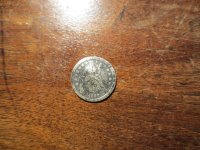Hey fellow prospectors and treasure hunters. I started this thread to see what people had to say about gold still in South Carolina. I aq'uired a small tract of land in Smyrna, York County. Land has been untouched since the California rush (except the little old lady that lived there since 1912). Basically I'm wondering has anyone ever picked up a nug in SC. I understand that it would be rare and would be quartz, not like a nug found in the west. If anyone knows of the Dixon Mine, Martin Mine, Horn Mine, or Southern Gold Mine which all closed in 1939 I think by Roosevelt because of the war. I'm near there. They were pulling some good size nugs from the myths. So let me know of your stories of gold found in SC.
Using a White's GMT. So far about 20 hrs. prospecting. Digging everything under 85% iron somtimes I dig targets anyway off of fence lines. Slow going lots of nails and .22 cal. bullets in rocky soil. Found a few buttons with no markings and some worn down axe heads about 14" down under large roots. Makes you wonder what happened to make someone be so careless with such a valuable asset of the time. I'm going to search it all of course, consentrating on the tickest areas of the forest first since the leaves are down and try to hit as many ridges and hillsides before summer slows things even worse. I'm detecting the area first then I'll dig some prostpecting pits. What gold have you guys seen in SC?
Using a White's GMT. So far about 20 hrs. prospecting. Digging everything under 85% iron somtimes I dig targets anyway off of fence lines. Slow going lots of nails and .22 cal. bullets in rocky soil. Found a few buttons with no markings and some worn down axe heads about 14" down under large roots. Makes you wonder what happened to make someone be so careless with such a valuable asset of the time. I'm going to search it all of course, consentrating on the tickest areas of the forest first since the leaves are down and try to hit as many ridges and hillsides before summer slows things even worse. I'm detecting the area first then I'll dig some prostpecting pits. What gold have you guys seen in SC?
Last edited:
Upvote
0






